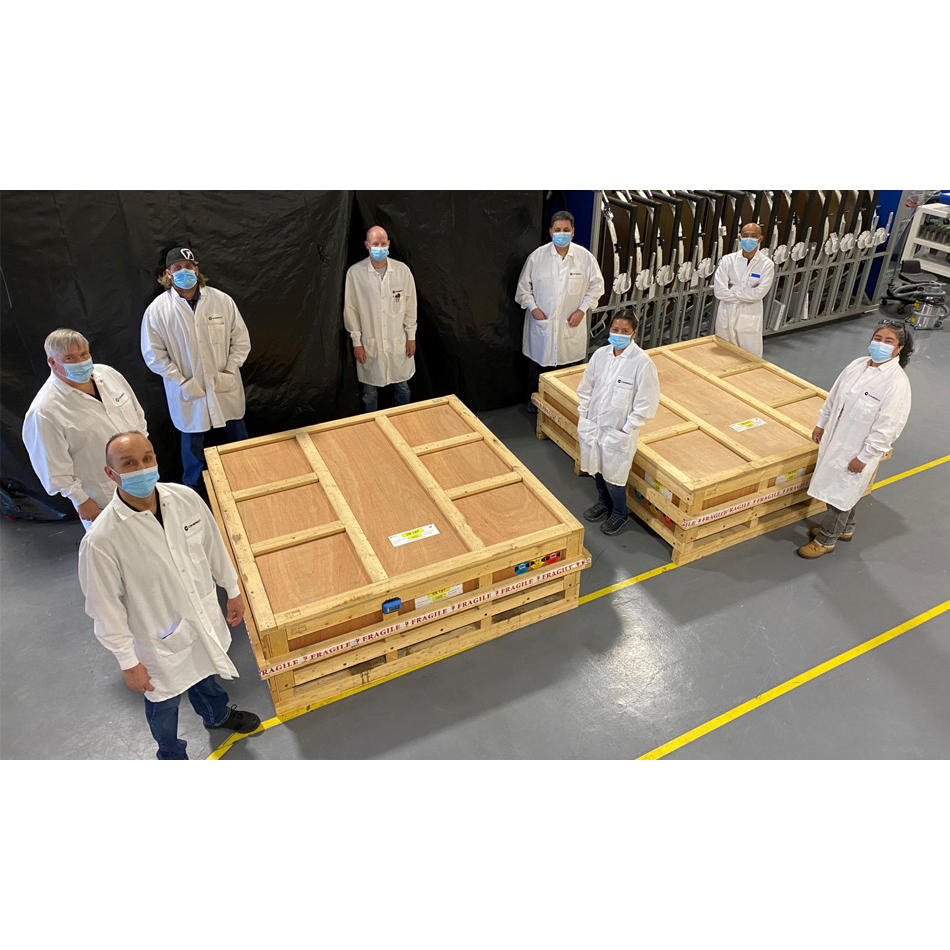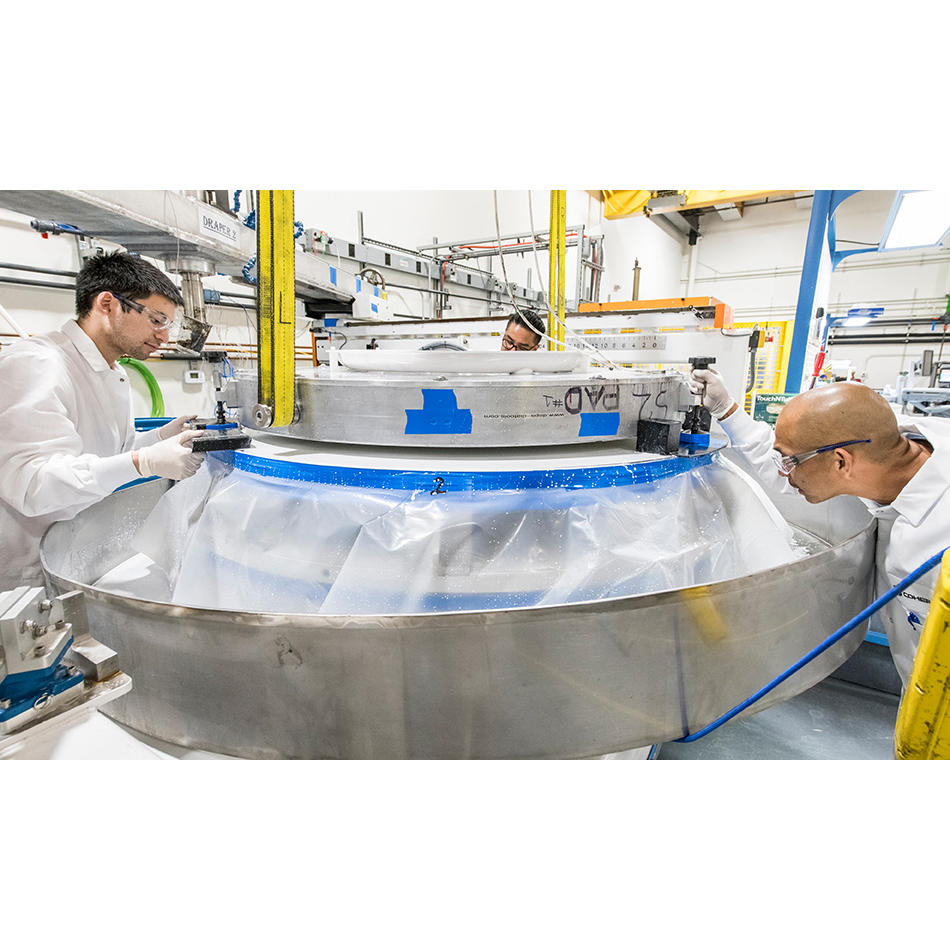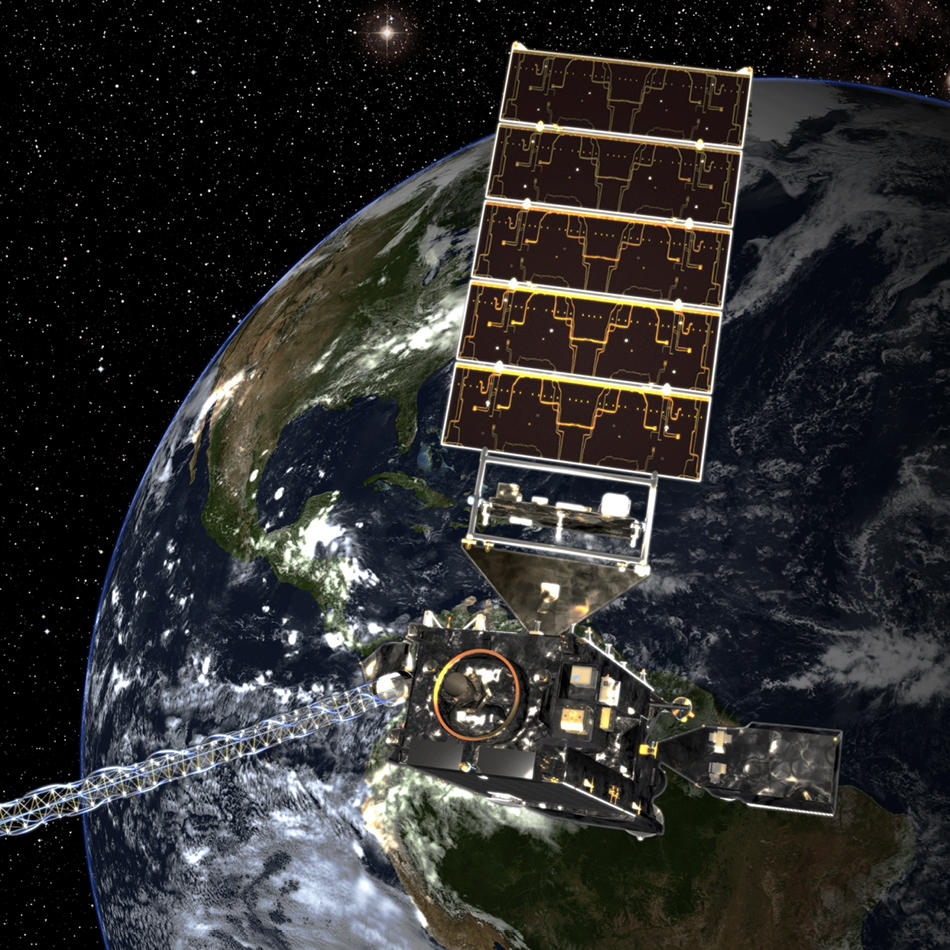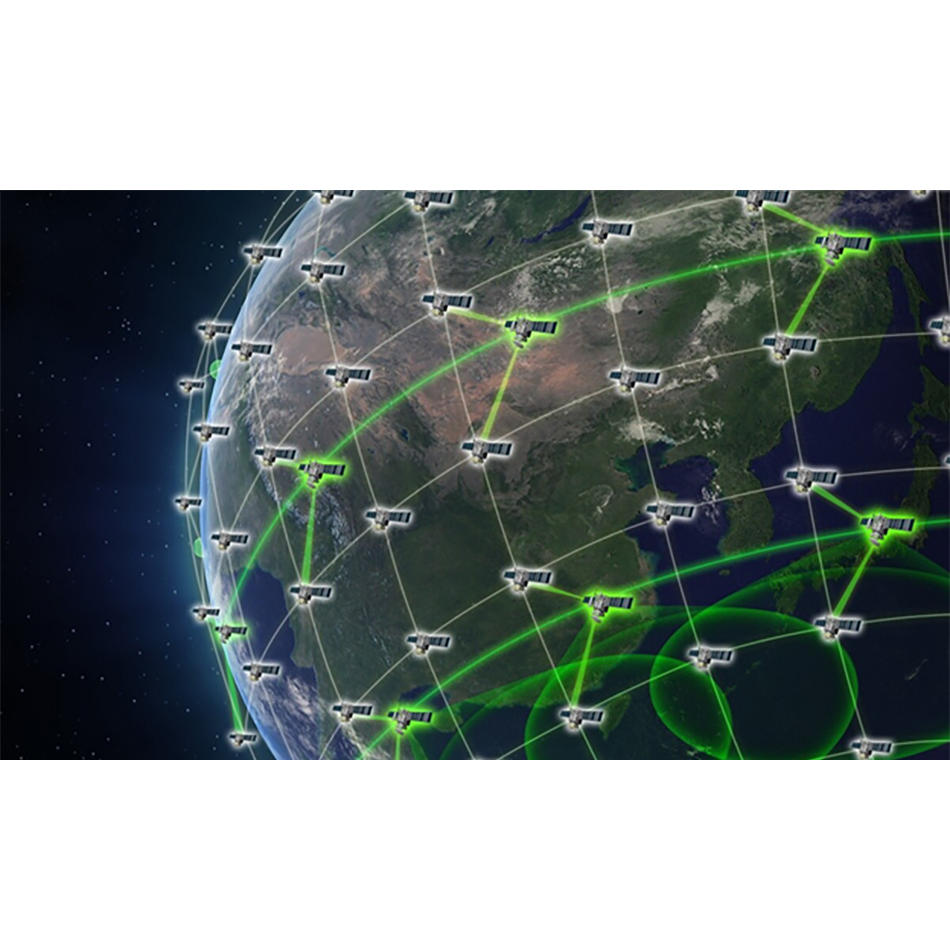대형 정밀 광학을 위한 더 빠른 처리
바카라 카지노는 직경 1.5m의 30미터 망원경 미러 세그먼트의 "헥싱" 속도를 높이기 위해 고급 초음파 공작 기계를 설치합니다.
2023년 8월 24일 작성자 일관적인
망원경 거울은 클수록 좋습니다. 빛의 기본적인 물리학에 따르면 망원경의 조리개 크기가 커질수록 이미지는 더 밝고 세밀해집니다. 이론적으로는.
실제로 거울 크기가 커질수록 높은 이미지 품질을 생성할 수 있을 만큼 정확한 표면 모양으로 거울을 만드는 것이 더 어려워집니다. 현재 거울 크기에 대한 실질적인 제한은 직경 약 8.5m입니다.
그러나 과학자들은 이러한 제한을 피하기 위해 매우 영리한 해결 방법을 개발했습니다. 하나의 큰 망원경 거울을 만드는 대신, 그들은 이제 하나의 큰 거울처럼 작동하는 작은 거울들의 모자이크를 사용합니다. 이러한 개별 세그먼트는 일반적으로 서로 매우 가깝게 배치될 수 있도록 육각형 모양으로 되어 있습니다.

여기에 표시된 제임스 웹 우주 망원경 주경과 같은 대형 망원경 거울은 종종 서로 가깝게 배치된 수많은 육각형 조각으로 구성됩니다(2mm 이내). 이미지 제공: NASA 고다드 우주 센터.
이것이 바로 30미터 망원경을 구성하는 데 사용되는 접근 방식입니다. 이 지상 관측소는 허블 우주 망원경보다 12배 이상, JWST보다 4배 더 선명한 (적외선) 이미지를 전달하기 위한 것입니다.
30미터 망원경 주경은 492개의 육각형 조각으로 구성되며 각 조각은 모서리에서 모서리까지의 길이가 1.44m입니다.바카라 카지노는 이러한 미러 세그먼트 중 230개를 제작하고 있습니다..
이 거울은 직경 1.5m의 둥근 모양으로 시작합니다. 축을 벗어난 쌍곡선의 자유형 모양을 생성하기 위해 우리가 사용하는 "응력 거울 연마" 기술에는 견고하고 대칭적인 둥근 기판이 필요하기 때문에 이는 필요합니다. 초기 연마 공정 후에 이러한 둥근 거울("원형")은 육각형("육각") 모양으로 만들어집니다.

바카라 카지노에서 제작 중인 230개의 TMT 원형 판은 각각 직경이 1.5m이며 이후 가장자리에서 가장자리까지 1.44m까지 "육각" 처리됩니다.
이때 거울 측면에도 기타 정밀 장착 기능이 추가되었습니다. 특히 이러한 "센서 포켓"은 최상의 이미지 품질을 유지하기 위해 실시간으로 미러 위치를 지정하는 센서 및 액추에이터 네트워크용입니다. 이를 통해 지상 기반 TMT는 우주 기반 장비의 적외선 공간 분해능을 능가할 수 있습니다.
가공 유리
이런 종류의 성형은 광학 제조에서 흔히 볼 수 있으며 일반적으로 컴퓨터 수치 제어(CNC)로 작동되는 전통적인 밀링 머신으로 수행됩니다. 그러나 광학에 사용되는 다양한 유리 재료는 부서지기 쉽고 금속보다 기계 가공이 더 어렵습니다. 작업하려면 다이아몬드 도구가 필요합니다.
다이아몬드 공작 기계는 100년 넘게 사용되어 왔습니다. 그들은 훌륭하게 작동하며 광학 산업 전반에 걸쳐 널리 활용됩니다. 그러나 현대 자동화를 통해 더 빠르고 효율적으로 작업할 수 있음에도 불구하고 여전히 상대적으로 느립니다. 이는 대형 광학 장치에서 대량의 재료를 제거할 때 때때로 문제가 됩니다.
바카라 카지노(이전의 Tinsley Optical Systems) 엔지니어들은 우리가 TMT용으로 만들고 있는 230개의 라운델을 육각형으로 만드는 작업을 맡을 때 이러한 제한에 정면으로 직면했습니다. 우리는 앞으로 몇 년에 걸쳐 해당 프로그램을 완료하고 싶습니다.
아마도 시간은 충분할 것 같습니다. 그렇지 않습니다! 각 원형이 연속적으로(단일 기계에서 차례로) 육각형으로 가공되는 경우 전통적인 밀링 시스템을 사용하여 그 많은 원형을 육각형으로 가공하는 데 일반적으로 10년이 더 걸릴 것입니다.
헥싱 속도 향상
지난 몇 년 동안 도구 제작자들은 고급 형태의 초음파 가공을 통합하는 시스템을 개발했습니다. 특히 여기에는 표준 고속 공구 회전 외에도 축을 따라 다이아몬드 공구의 작은 진폭, 빠른 진동(수십 kHz 범위)이 포함됩니다.
이 기술은 몇 가지 중요한 이점을 제공합니다. 첫째, 기존 다이아몬드 공구 밀링보다 6~10배 빠른 소재 제거율을 달성합니다. 또한 초음파 도구는 기존 도구보다 공작물에 더 적은 힘을 가하기 때문에 일반적으로 물리적인 부품 왜곡을 방지하는 기계적 응력이 거의 발생하지 않습니다. 이를 통해 표면 아래 손상이 줄어들고 마감이 더욱 매끄러워지며 벽이 더 얇은 제품을 생산할 수 있습니다.
또한 힘이 낮을수록 도구 마모가 줄어들어 수명이 연장됩니다. 게다가 초음파 도구는 "자가 드레싱"입니다. 즉, 사용을 통해 새로운 다이아몬드 입자가 공구에 자동으로 노출되어 절삭력이 유지됩니다. 일반적으로 도구는 주기적으로 제거하고 별도의 작업으로 드레싱해야 합니다. 도구 교체 및 유지 관리 빈도가 낮아지면 장비 가동 중지 시간이 줄어듭니다.
특히 반도체 산업의 대형 고정밀 부품 제조업체는 바로 이러한 이유로 초음파 보조 가공을 채택했습니다. 그러나 현재까지 이 기술은 항공우주 및 천문학 응용 분야의 대형 광학 부품에 사용되지 않았습니다.
초음파 사용 준비
바카라 카지노는 TMT 라운델을 육각형으로 만들 수 있을 만큼 큰 초음파 보조 가공 시스템을 설치하여 이를 수행한 최초의 기업이 되었습니다. 우리는 또한 절단 공정 중에 머시닝 센터 내에서 광학 장치를 고정하기 위한 매우 특수한 도구를 개발했습니다.
직경 1.5m 원형판의 무게는 0.25미터톤(550파운드)이지만 두께가 45mm에 불과하기 때문에 이 도구는 매우 중요합니다. 따라서 비대칭적이거나 국지적인 기계적 힘을 가하는 방식으로 잡고 있으면 모양이 왜곡되기가 매우 쉽습니다. 이로 인해 절단 후 고정 장치에서 부품이 풀릴 때 부품이 "튀어나올" 수 있습니다. 즉, 가공된 형상이 더 이상 사양을 충족하지 못할 정도로 모양이 변경됩니다.
따라서 "제로 스트레스 장착"을 사용해야 합니다. 특히 이는 둥근 모양의 표면 모양이 왜곡되는 것을 피하면서 광학 장치가 밀링 공정의 힘에 대해 견고하게 유지되도록 하는 장착 방법입니다.
가공을 위해 광학 장치를 장착할 때 일반적인 접근 방식은 진공 척을 사용하는 것입니다. 그러나 이 방법으로는 TMT 원형판의 크기와 정밀도와 같은 자유형(비대칭 및 비구면) 광학 장치의 제로 응력 장착을 달성할 수 있는 방법이 없습니다. 거울과 일치할 만큼 정확한 모양의 장착 표면을 만드는 것은 불가능합니다.

초음파 보조 가공 시스템은 현재 바카라 카지노에서 제조되고 있는 230개 라운델의 정밀 육각 가공을 처리하도록 구성됩니다.
대신 바카라 카지노 엔지니어들은 지지 및 클램핑 시스템의 다중 기술 네트워크를 사용하는 독점 도구 접근 방식을 개발했습니다. 이는 굽힘을 가하지 않고 모든 자유도에서 부품을 고정합니다.
라운델을 육각형으로 가공하는 데 필요한 절단 정밀도를 유지하려면 전체 머시닝 센터가 매우 안정적인 기초 위에 놓여 있는 것도 중요합니다. 그리고 주변 환경 조건도 일정하게 유지되어야 합니다. 하지만 이 공작기계는 픽업트럭보다 크고 무겁다는 점을 명심하세요.
결과적으로 우리는 그것을 보관할 목적으로 지어진 시설을 만들어야 했습니다. 이는 기계의 무게를 지탱하고 필요한 기계적 안정성을 제공하기 위해 철근으로 광범위하게 강화된 새로운 콘크리트 장착 패드를 붓는 것부터 시작되었습니다. 또한, 주변 환경의 변화를 없애기 위해 생산 영역 전체의 온도 관리를 개선했습니다.
헥싱 이전의 라운델 광학 제조 공정에 대해 자세히 알아보기여기.



